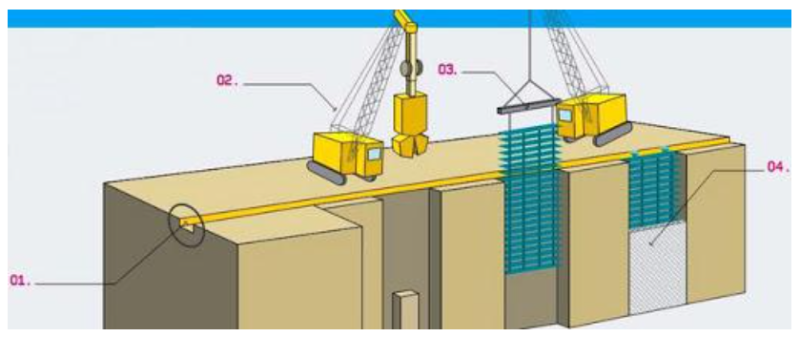The earth retaining wall is an extremely sturdy structure, constructed with reinforced concrete that is entirely embedded within the ground.
An earth retaining wall is a reinforced concrete structure with a thickness ranging from 60 cm to 1.5 m (walls for high-rise building basements typically use a thickness from 60 cm to 1 m depending on specific requirements, with some walls requiring depth to withstand soft clay or semi-hard clay).
During the design and construction process of earth retaining walls, they are interconnected through waterproofing panels to build a sturdy concrete wall, usually rectangular in shape and with the current maximum depth of up to 100m.

Image of construction of LGD Sky apartment complex using the earth retaining wall method by Duafat Joint Stock Company.

Simulating the construction plan of an earth retaining wall.
4. Rational design: Calculate dimensions, thickness, and height of the wall to ensure structural integrity and suitability for the terrain and intended use.
5. Consideration of drainage system: Especially important if the earth retaining wall is located in an area prone to heavy rainfall. A proper drainage system must be carefully designed to prevent soil erosion and wall damage.
6.Proper construction techniques: Utilize correct construction techniques to ensure accuracy and durability of the earth retaining wall. Excavation and material assembly must be carried out meticulously.
7. Regular inspection and maintenance: Upon completion, the earth retaining wall should undergo regular inspection and maintenance to ensure safety and longevity.
8. Compliance with legal regulations: Ensure compliance with all relevant legal regulations concerning the design and construction of earth retaining walls before commencing the project.
Planning and constructing an earth retaining wall require careful consideration and attention to detail from initial assessment to implementation and maintenance. Make sure to consider and apply these important notes to achieve the best results for your project.
Ban truyền thông


 VN
VN CN
CN KR
KR JP
JP